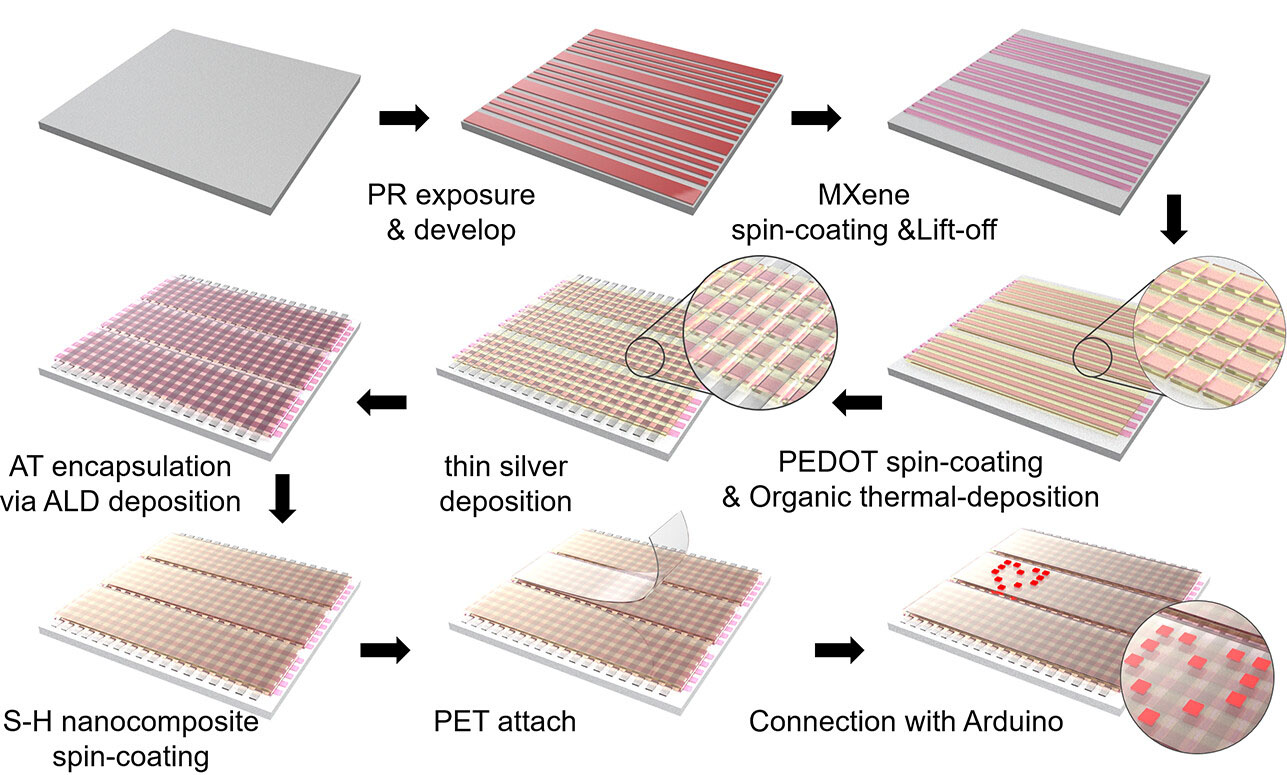| Jul 25, 2023 |
Transparent flexible OLED withstands 6 hours of washing
(Nanowerk News) A research team led by Professor Choi Kyung-cheol from the School of EE, in collaboration with Dr. Lee Yong-hee’s team from the Institute for National Nanofab Center, has successfully developed a waterproof transparent flexible OLED that can display light and show the background even when exposed to water, using MXene nanotechnology.
|
|
The research has been published in ACS Nano ("Highly Air-Stable, Flexible, and Water-Resistive 2D Titanium Carbide MXene-Based RGB Organic Light-Emitting Diode Displays for Transparent Free-Form Electronics").
|
 |
| Fabrication process of the MXene-based OLED passive matrix display. (© American Chemical Society)
|
|
Despite the advantages of MXene materials, such as high electrical conductivity, transparency, and large-scale production through solution processes, its use in high-performance electronic devices has been limited due to its susceptibility to degradation of electrical property, caused by moisture or water.
|
|
This prevented the development of a system in the form of a matrix that allows display of information. Professor Choi’s research team developed a moisture-resistant MXene-based OLED with long-term stability by employing an encapsulation strategy to prevent oxidation by moisture or oxygen.
|
|
The team firstly focused on analyzing the degradation mechanism of MXene’s electrical properties caused by moisture and then focused on designing an encapsulation layer.
|
|
The team designed a bilayer encapsulation structure by introducing moisture barrier and residual stress compensation technologies to provide flexibility. Additionally, they attached a thin plastic film with a thickness of several tens of micrometers on the top to enable underwater washing.
|
|
Through this research, the team developed MXene-based OLEDs in red (R), green (G), and blue (B) colors that achieve a brightness of over 1,000 cd/m2, which is visible to the human eye even in outdoor display conditions under sunlight. The red MXene-based OLED demonstrated a storage lifetime of 2,000 hours (70% brightness retention), an operational lifetime of 1,500 hours (60% brightness retention), and flexibility that can withstand more than 1,000 bending cycles with a low curvature radius of 1.5mm.
|
|
Moreover, the OLED maintained 80% of its brightness even after being immersed in water for six hours. The team also demonstrated the production of a transparent display capable of displaying characters or patterns using patterning techniques to create a passive-matrix form of MXene-based OLEDs.
|
|
So Yeoung Jeong , a doctoral candidate in Professor Choi’s research team who led this research, stated, “We focused on designing encapsulation structures and processes suitable for MXene OLEDs to improve their reliability.”
|
|
She added, “By producing MXene-based OLEDs in a matrix type, we have laid the foundation for the application of MXene in the field of transparent displays, allowing simple character or pattern display.”
|
|
Professor Choi stated, “This research not only provides guidelines for the application of MXene in various electronic components but also applicable to various fields such as vehicle displays, fashion, and functional clothing, where transparent flexible displays are required. In order to widen the technology gap with China in OLED technology, continuous development of new OLED technologies is necessary.”
|

